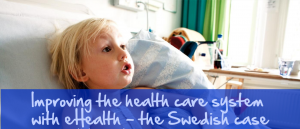
eHealth means different things to different people. While to most people, eHealth is just relegated to increased use of electronic patient records, eHealth is actually a lot more than that. The Journal of Medical Internet Research, JMIR, describes eHealth as the convergence of “medical informatics, public health, and business, referring to health services and information delivered or enhanced through the Internet and related technologies”.
Needless to say, eHealth is playing a larger role with each passing year, and more specifically in the area of preventive patient care. But what has prompted this trend or movement towards eHealth? This can be best understood by taking examples of specific countries as against a complete world-view. Sweden, which has been at the forefront of automation in every sphere of life, places a lot of emphasis on eHealth initiatives.
A report published by the Ministry of Health and Social Affairs, Govt of Sweden documents various challenges in today’s Healthcare sector. While the study covered Sweden in particular, most of these challenges are common to many countries.
• Empowering the patient
• Managing geographical and socioeconomic inequities in health
• Improving patient safety
• Shorter waiting times and better access
• Managing a new disease panorama, pandemics, resistant bacteria, lifestyle diseases
• Further developing IT-services to support healthcare
• Population group over 65 years of age will increase by 28% before year 2020
• Healthcare expenditure is expected to increase by 20% before year 2030
Each of these challenges are significant. For example, when it comes to waiting time, hospitals have long queues of patients waiting to receive care. This and the fact that there are a large number of older patients mean, healthcare is gradually shifting to the homes of patients. However, with lack of an intelligent Healthcare systems, nursing is done too early, by the hour, or too late, when something has already happened, and not precisely when needed.
That is, nursing needs are planned by the hour whether they are needed or not, as a result, resources are being used when an incident or accident has already occurred. This means that resources which are in short supply are further stretched, when they should instead be used for preventive patient care.
IoT-enabled eHealth addresses challenges like these through connected health devices and sensor data. Smart sensors or patient activities monitored by sensors, connected hospitals and care centers help improve nursing surveillance and lead to initiatives like smart diapers, monitoring leaving from bed, prevent accidental falling from bed, and create a culture of open doors or open medicine. Data analytics in conjunction with continued business improvement can change the healthcare landscape drastically.
The Swedish Health Ministry report has also documented the benefits of eHealth technologies. Some of them are:
• 10% reduction in hospital acquired Infections
• 17% reduction in adverse drug events
• 41% reduction in drug interaction errors
• 52% rise in patients with documented self management goals
• 7% reduction in average length of stay in hospital
• 48% reduction in duplicate laboratory/chemistry tests
• 19% reduction in hospital admissions for chronic conditions
• 83% reduction in medication errors due to mistaken identity
As is evident, eHealth has far-reaching impact on Healthcare. As per a Gartner study, eHealth contributes significantly to:
• Patient Safety
• Quality of Care
• Availability
• Empowerment of the patient
• Continuity of Care
If you are a Hospital Administrator or a Health Policy maker, it’s now time to re-evaluate your Healthcare environment and incorporate more eHealth initiatives, for both short-term and long-term gains.